The first hard disk drive
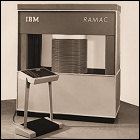 IBM announces the IBM 305 RAMAC (Random Access Memory Accounting) mainframe, a computer as large as two refrigerators, containing the new 350 Disk Storage Unit, the world’s first hard disk drive. The nearly-six-foot-high drive consists of a huge metal case surrounding a towering stack of 50 double-sided magnetic platters, adding up to a total capacity of four megabytes. In 1958, IBM will introduce the option to double capacity by adding a second stack of drive platters to the casing. The 305 RAMAC and 350 Disk Storage Unit together weigh over a ton, and are leased to IBM’s clients for $3,200 per month.
IBM announces the IBM 305 RAMAC (Random Access Memory Accounting) mainframe, a computer as large as two refrigerators, containing the new 350 Disk Storage Unit, the world’s first hard disk drive. The nearly-six-foot-high drive consists of a huge metal case surrounding a towering stack of 50 double-sided magnetic platters, adding up to a total capacity of four megabytes. In 1958, IBM will introduce the option to double capacity by adding a second stack of drive platters to the casing. The 305 RAMAC and 350 Disk Storage Unit together weigh over a ton, and are leased to IBM’s clients for $3,200 per month.
Videotape
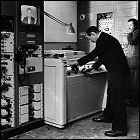 At the National Association of Broadcasters (NAB) convention in Chicago, Ampex demonstrates the first commercially-available videotape deck, the Ampex VRX-1000 Quad VTR, using two-inch-wide open-reel videotape, in spools with a 14-inch diameter, to record and play back up to an hour of television programming. Over the next four days, Ampex receives orders from broadcasters totaling over two million dollars. CBS will give the VRX-1000 its first national on-air use in November, tape-delaying a newscast to its stations on the west coast, allowing the first broadcast of a single program at the same hour in different time zones. NBC will also have the VRX-1000 in use at the beginning of 1957. A newer model capable of recording and playing back programming in full color will become available in 1958. Though it does not record at the same resolution as film, the relative ease of use of videotape will see it replace kinescope film in most TV operations.
At the National Association of Broadcasters (NAB) convention in Chicago, Ampex demonstrates the first commercially-available videotape deck, the Ampex VRX-1000 Quad VTR, using two-inch-wide open-reel videotape, in spools with a 14-inch diameter, to record and play back up to an hour of television programming. Over the next four days, Ampex receives orders from broadcasters totaling over two million dollars. CBS will give the VRX-1000 its first national on-air use in November, tape-delaying a newscast to its stations on the west coast, allowing the first broadcast of a single program at the same hour in different time zones. NBC will also have the VRX-1000 in use at the beginning of 1957. A newer model capable of recording and playing back programming in full color will become available in 1958. Though it does not record at the same resolution as film, the relative ease of use of videotape will see it replace kinescope film in most TV operations.
Nuclear Pulse Propulsion
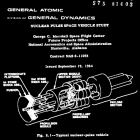 As part of a post-Manhattan-Project program of seeking peaceful uses for the technology previously developed for the construction and delivery of nuclear weapons, an informal report authored in August by C.J. Everett and Stanislaw Ulam is distributed from Los Alamos National Laboratory to the Atomic Energy Commission and other interested parties on this date. The report outlines a theoretical space propulsion system which would eject and detonate a series of nuclear explosives behind a spacecraft, pushing it forward at high velocity. The suggested spacecraft design would carry a pusher plate and shock-absorber system to minimize the acceleration effects on crew members in a shielded payload section. This is the culmination of a series of ideas Ulam had devised over the past decade, which would theoretically put interplanetary or even interstellar travel within reach. As the space race heats up, Ulam and Everett’s proposal will be revisited and expanded upon, at least on paper; physicist Freeman Dyson, in particular, will spend considerable time and research on what will come to be known as Project Orion (unrelated to the 21st century Orion crewed spacecraft design).
As part of a post-Manhattan-Project program of seeking peaceful uses for the technology previously developed for the construction and delivery of nuclear weapons, an informal report authored in August by C.J. Everett and Stanislaw Ulam is distributed from Los Alamos National Laboratory to the Atomic Energy Commission and other interested parties on this date. The report outlines a theoretical space propulsion system which would eject and detonate a series of nuclear explosives behind a spacecraft, pushing it forward at high velocity. The suggested spacecraft design would carry a pusher plate and shock-absorber system to minimize the acceleration effects on crew members in a shielded payload section. This is the culmination of a series of ideas Ulam had devised over the past decade, which would theoretically put interplanetary or even interstellar travel within reach. As the space race heats up, Ulam and Everett’s proposal will be revisited and expanded upon, at least on paper; physicist Freeman Dyson, in particular, will spend considerable time and research on what will come to be known as Project Orion (unrelated to the 21st century Orion crewed spacecraft design).
Did an asteroid kill the dinosaurs?
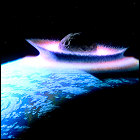 M. W. De Laubenfels of Oregon State College submits an article to the Journal of Paleontology, proposing the idea that an asteroid collision with Earth caused the extinction of the dinosaurs. Citing the widespread damage caused by a comet or meteor’s explosion over the ground in 1908 in Tunguska, Siberia, Laubenfels postulates that an actual impact could have displaced enough material to block the sun, wiping out vegetation and smaller animals alike, choking off the dinosaurs’ food supply as well as dropping surface temperatures below survivable levels. At the time of publication, the possibility of an asteroidal collision with Earth is not thought to be a particularly major threat.
M. W. De Laubenfels of Oregon State College submits an article to the Journal of Paleontology, proposing the idea that an asteroid collision with Earth caused the extinction of the dinosaurs. Citing the widespread damage caused by a comet or meteor’s explosion over the ground in 1908 in Tunguska, Siberia, Laubenfels postulates that an actual impact could have displaced enough material to block the sun, wiping out vegetation and smaller animals alike, choking off the dinosaurs’ food supply as well as dropping surface temperatures below survivable levels. At the time of publication, the possibility of an asteroidal collision with Earth is not thought to be a particularly major threat.
The Severe Local Storms Warning Service
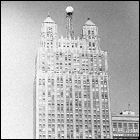 Formerly the Weather Bureau-Army-Navy Severe Weather Unit, the recently-renamed Severe Local Storms Warning Service (SELS) relocates from Washington D.C. to Kansas City, Missouri. The new location puts the SELS closer to the American midwest, a hotbed of severe weather during the spring months, as well as placing it in close proximity to a major telecommunications hub (at this point, the SELS is reliant almost entirely on teletype transmissions). Additionally, precise definitions of what constitutes a severe thunderstorm (winds in excess of 50mph, wind gusts in excess of 75mph, and hail in excess of an inch in diameter) are established, as well as a concerted effort to target its weather bulletins to more precise geographic regions.
Formerly the Weather Bureau-Army-Navy Severe Weather Unit, the recently-renamed Severe Local Storms Warning Service (SELS) relocates from Washington D.C. to Kansas City, Missouri. The new location puts the SELS closer to the American midwest, a hotbed of severe weather during the spring months, as well as placing it in close proximity to a major telecommunications hub (at this point, the SELS is reliant almost entirely on teletype transmissions). Additionally, precise definitions of what constitutes a severe thunderstorm (winds in excess of 50mph, wind gusts in excess of 75mph, and hail in excess of an inch in diameter) are established, as well as a concerted effort to target its weather bulletins to more precise geographic regions.
Castle Bravo
 The United States’ thermonuclear testing program Operation Castle commences with the first detonation, code named Castle Bravo, on a reef near Bikini Atoll. The most powerful hydrogen bomb detonation carried out by the American military during the 20th century, Castle Bravo has a yield of 15 megatons, three times greater than predicted, with a blast radius of over four miles. Radioactive fallout spreads over 7,000 square miles of the Pacific Ocean, including neighboring islands and a Japanese fishing boat, with both populations showing symptoms of radiation sickness shortly afterward, forcing evacuations and later reparations.
The United States’ thermonuclear testing program Operation Castle commences with the first detonation, code named Castle Bravo, on a reef near Bikini Atoll. The most powerful hydrogen bomb detonation carried out by the American military during the 20th century, Castle Bravo has a yield of 15 megatons, three times greater than predicted, with a blast radius of over four miles. Radioactive fallout spreads over 7,000 square miles of the Pacific Ocean, including neighboring islands and a Japanese fishing boat, with both populations showing symptoms of radiation sickness shortly afterward, forcing evacuations and later reparations.
RDS-6s
 The Soviet Union detonates its first hydrogen bomb, code named RDS-6s, in its first thermonuclear weapons demonstration. The bomb is estimated to have a yield of 400 kilotons, thanks to a layered design devised by nuclear physicist (and later political exile) Andrei Sakharov, though Sakharov’s design is incapable of being scaled up, ending its use in later Soviet nuclear weapon designs.
The Soviet Union detonates its first hydrogen bomb, code named RDS-6s, in its first thermonuclear weapons demonstration. The bomb is estimated to have a yield of 400 kilotons, thanks to a layered design devised by nuclear physicist (and later political exile) Andrei Sakharov, though Sakharov’s design is incapable of being scaled up, ending its use in later Soviet nuclear weapon designs.
Hook echo: first tornado detected by radar
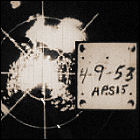 Using a World War II-era aviation radar system, Illinois State Water Survey electrical engineer Donald Staggs makes the first radar-based detection of a nearby tornado, part of a tornado outbreak striking in and near Champaign, Illinois. The “hook echo” is the distinctive radar signature of a rapidly evolving small-scale cyclone developing from the larger radar signature of its parent thunderstorm. Continued observations confirm that this is the “radar shape” of a forming tornado, an invaluable piece of information for forecasters on the forefront of severe weather prediction.
Using a World War II-era aviation radar system, Illinois State Water Survey electrical engineer Donald Staggs makes the first radar-based detection of a nearby tornado, part of a tornado outbreak striking in and near Champaign, Illinois. The “hook echo” is the distinctive radar signature of a rapidly evolving small-scale cyclone developing from the larger radar signature of its parent thunderstorm. Continued observations confirm that this is the “radar shape” of a forming tornado, an invaluable piece of information for forecasters on the forefront of severe weather prediction.
Ivy Mike
 The United States conducts the first-ever successful test of a thermonuclear bomb at Enewetak Atoll in the Pacific Ocean as part of Operation Ivy. The explosion resulting from the first hydrogen bomb test has a yield equivalent to 10 megatons of TNT, with a three-mile blast radius, stripping vegetation from the ground in the surrounding area. There is significant radiological fallout from the event, and one pilot assigned to fly a jet fighter through the area an hour after the detonation loses control of his plane, crashes, and dies due to residual radiation interfering with his instruments and controls. Traces of the previously undiscovered (but theorized) elements einsteinium and fermium are found afterward.
The United States conducts the first-ever successful test of a thermonuclear bomb at Enewetak Atoll in the Pacific Ocean as part of Operation Ivy. The explosion resulting from the first hydrogen bomb test has a yield equivalent to 10 megatons of TNT, with a three-mile blast radius, stripping vegetation from the ground in the surrounding area. There is significant radiological fallout from the event, and one pilot assigned to fly a jet fighter through the area an hour after the detonation loses control of his plane, crashes, and dies due to residual radiation interfering with his instruments and controls. Traces of the previously undiscovered (but theorized) elements einsteinium and fermium are found afterward.
Operation Hurricane
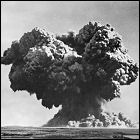 Operation Hurricane, the first test detonation of a British-built atomic bomb, takes place aboard a Royal Navy frigate anchored near the Monte Bello Islands off of the western Australian coast. The detonation has a yield of 25 kilotons, and is remotely detonated aboard the frigate to gauge the damage that would result from a scenario in which a nuclear device is smuggled into a sea port aboard a ship. This is a continuation of Britain’s own nuclear weapon development program initiated during World War II, and makes the U.K. the third nuclear-armed nation on Earth.
Operation Hurricane, the first test detonation of a British-built atomic bomb, takes place aboard a Royal Navy frigate anchored near the Monte Bello Islands off of the western Australian coast. The detonation has a yield of 25 kilotons, and is remotely detonated aboard the frigate to gauge the damage that would result from a scenario in which a nuclear device is smuggled into a sea port aboard a ship. This is a continuation of Britain’s own nuclear weapon development program initiated during World War II, and makes the U.K. the third nuclear-armed nation on Earth.
Tornado Bulletin #2
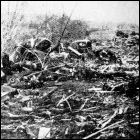 The newly formed Weather Bureau-Army-Navy Severe Weather Unit‘s second attempt to warn the public that tornado formation is possible within a specific area strikes paydirt. Again covering a large area including portions of Texas, Oklahoma, Arkansas, and Louisiana, later expanded to include states east of this area, this forerunner of modern tornado watches is right on the money, predicting an outbreak of more than 20 tornadoes in Arkansas, Missouri, Mississippi and Kentucky. Despite the advance notification, the Severe Weather Unit has work to do in educating the public about its bulletins: over 200 deaths still occur as a result of the tornadoes.
The newly formed Weather Bureau-Army-Navy Severe Weather Unit‘s second attempt to warn the public that tornado formation is possible within a specific area strikes paydirt. Again covering a large area including portions of Texas, Oklahoma, Arkansas, and Louisiana, later expanded to include states east of this area, this forerunner of modern tornado watches is right on the money, predicting an outbreak of more than 20 tornadoes in Arkansas, Missouri, Mississippi and Kentucky. Despite the advance notification, the Severe Weather Unit has work to do in educating the public about its bulletins: over 200 deaths still occur as a result of the tornadoes.
Baptism by fire…and wind
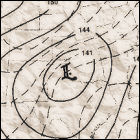 The newly formed Weather Bureau-Army-Navy Severe Weather Unit hits the ground running with its first tornado bulletin issued to the general public for portions of Texas, Oklahoma, Arkansas and Louisiana. This forerunner of the modern tornado watch is a misfire, however: the only two confirmed tornadoes occur, both outside the area covered in the bulletin. Critics within the Weather Bureau express doubt that such bulletins will ever be of use to the public, and may instead spark panic among the public; this attitude will all but disappear within three years.
The newly formed Weather Bureau-Army-Navy Severe Weather Unit hits the ground running with its first tornado bulletin issued to the general public for portions of Texas, Oklahoma, Arkansas and Louisiana. This forerunner of the modern tornado watch is a misfire, however: the only two confirmed tornadoes occur, both outside the area covered in the bulletin. Critics within the Weather Bureau express doubt that such bulletins will ever be of use to the public, and may instead spark panic among the public; this attitude will all but disappear within three years.
Weather Bulletin!
 The U.S. Weather Bureau (forerunner of the National Weather Service) inaugurates the Severe Weather Unit at the WBAN (Weather Bureau-Army-Navy) Analysis Center in Washington D.C. Armed with recent research and decades of past research into the formation and behavior of severe thunderstorms and tornadoes, this is the first attempt to offer the military’s growing severe weather prediction capability to the American public. In these early days, before the adoption of specific types of weather watches, the WBAN Severe Weather Unit issues weather bulletins for tornadoes and severe thunderstorms alike; by early 1953, the Severe Weather Unit also issues “outlooks” with more general predictions about the probability of severe storms.
The U.S. Weather Bureau (forerunner of the National Weather Service) inaugurates the Severe Weather Unit at the WBAN (Weather Bureau-Army-Navy) Analysis Center in Washington D.C. Armed with recent research and decades of past research into the formation and behavior of severe thunderstorms and tornadoes, this is the first attempt to offer the military’s growing severe weather prediction capability to the American public. In these early days, before the adoption of specific types of weather watches, the WBAN Severe Weather Unit issues weather bulletins for tornadoes and severe thunderstorms alike; by early 1953, the Severe Weather Unit also issues “outlooks” with more general predictions about the probability of severe storms.
Weather Radio: all weather, all the time
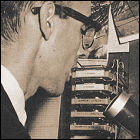 The U.S. Weather bureau signs on radio station KWO35, located at New York’s La Guardia Airport, broadcasting weather forecasts primarily for the benefit of pilots. Not targeted for public consumption, the experimental station broadcasts for several hours a day at a frequency of 162.55Mhz, outside of the spectrum reserved for FM radio. A similar station on the same frequency will later sign on at Chicago’s O’Hare Airport in 1953, again mainly for the consumption of airline pilots. Marine forecasts are added later, and the system helps the Weather Bureau prevent its local forecasters from being overwhelmed by requests for “personalized” weather reports for pilots. These two stations are the precursor for the nationwide weather radio network operated by the Weather Bureau’s successor agency, the National Weather Service.
The U.S. Weather bureau signs on radio station KWO35, located at New York’s La Guardia Airport, broadcasting weather forecasts primarily for the benefit of pilots. Not targeted for public consumption, the experimental station broadcasts for several hours a day at a frequency of 162.55Mhz, outside of the spectrum reserved for FM radio. A similar station on the same frequency will later sign on at Chicago’s O’Hare Airport in 1953, again mainly for the consumption of airline pilots. Marine forecasts are added later, and the system helps the Weather Bureau prevent its local forecasters from being overwhelmed by requests for “personalized” weather reports for pilots. These two stations are the precursor for the nationwide weather radio network operated by the Weather Bureau’s successor agency, the National Weather Service.
Ananke
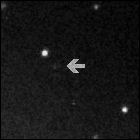 Using a telescope at Mount Wilson Observatory, astronomer Seth Nicholson discovers Ananke, a tiny moon of Jupiter orbiting the huge planet at an average distance of 21 million miles and at a high inclination relative to Jupiter’s equator. Ananke is most likely a captured asteroid or the remnant of a captured asteroid, and other small Jovian moons in the same orbit may be other pieces of the captured (and shredded) body. Ananke is the first Jovian moon discovered in nearly two decades, and it will be over two more decades before another is found.
Using a telescope at Mount Wilson Observatory, astronomer Seth Nicholson discovers Ananke, a tiny moon of Jupiter orbiting the huge planet at an average distance of 21 million miles and at a high inclination relative to Jupiter’s equator. Ananke is most likely a captured asteroid or the remnant of a captured asteroid, and other small Jovian moons in the same orbit may be other pieces of the captured (and shredded) body. Ananke is the first Jovian moon discovered in nearly two decades, and it will be over two more decades before another is found.
RDS-1
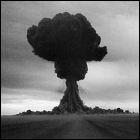 The Soviet Union detonates its first nuclear weapon, internally code named RDS-1, near a specially-built “dummy” village which includes various structures, aircraft and other military hardware, and livestock, all present to test the effects of an atomic weapon detonation in their vicinity. Western intelligence is caught off guard when the radioactive fallout is picked up by detection equipment on weather reconnaissance flights between Japan and Alaska, as the Soviets were not expected to have their own nuclear weapons until sometime in the 1950s. This is a turning point in the Cold War, initiating the race toward the next evolution of nuclear weapons: the hydrogen, or thermonuclear, bomb.
The Soviet Union detonates its first nuclear weapon, internally code named RDS-1, near a specially-built “dummy” village which includes various structures, aircraft and other military hardware, and livestock, all present to test the effects of an atomic weapon detonation in their vicinity. Western intelligence is caught off guard when the radioactive fallout is picked up by detection equipment on weather reconnaissance flights between Japan and Alaska, as the Soviets were not expected to have their own nuclear weapons until sometime in the 1950s. This is a turning point in the Cold War, initiating the race toward the next evolution of nuclear weapons: the hydrogen, or thermonuclear, bomb.
Operation Paperclip
 President Truman, after months of weighing the pros and cons of offering amnesty to many of the German scientists involved in the V2 rocket program, signs off on Operation Paperclip, a project to repatriate those scientists to the United States. The initial estimate is that a thousand German scientists will be brought to the U.S., but over time the total will grow closer to 2,000, bringing well over 3,000 family members with them. Wernher von Braun and Hermann Oberth are among the scientists and engineers who accept the offer to work for the U.S., and their efforts, while they do have military value, will form the core of the nascent U.S. space program, with von Braun eventually designing the Saturn V rocket that will take future astronauts to the moon. The Soviet Union mounts a similar program in the weeks to come, attempting to repatriate German scientists and engineers to continue their rocketry research for the Soviets.
President Truman, after months of weighing the pros and cons of offering amnesty to many of the German scientists involved in the V2 rocket program, signs off on Operation Paperclip, a project to repatriate those scientists to the United States. The initial estimate is that a thousand German scientists will be brought to the U.S., but over time the total will grow closer to 2,000, bringing well over 3,000 family members with them. Wernher von Braun and Hermann Oberth are among the scientists and engineers who accept the offer to work for the U.S., and their efforts, while they do have military value, will form the core of the nascent U.S. space program, with von Braun eventually designing the Saturn V rocket that will take future astronauts to the moon. The Soviet Union mounts a similar program in the weeks to come, attempting to repatriate German scientists and engineers to continue their rocketry research for the Soviets.
The Atomic Energy Act of 1946
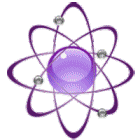 President Truman signs the Atomic Energy Act into law, laying the groundwork for both future military development of nuclear weapons and a civilian nuclear energy industry, though the latter will take time (and further amendments to the law) to develop. The primary development of the initial version of the law is the founding of the U.S. Atomic Energy Commission, a civilian agency intended to lead both areas of development (and intended to take over from the scientists who, up until now, had been operating in secret as part of the Manhattan Project). Over time, the Commission’s responsibilities will grow to include regulation, safety, and disposal of dangerous radioactive material. Major amendments will be made in 1954 under President Eisenhower to encourage the peacetime nuclear power industry to grow.
President Truman signs the Atomic Energy Act into law, laying the groundwork for both future military development of nuclear weapons and a civilian nuclear energy industry, though the latter will take time (and further amendments to the law) to develop. The primary development of the initial version of the law is the founding of the U.S. Atomic Energy Commission, a civilian agency intended to lead both areas of development (and intended to take over from the scientists who, up until now, had been operating in secret as part of the Manhattan Project). Over time, the Commission’s responsibilities will grow to include regulation, safety, and disposal of dangerous radioactive material. Major amendments will be made in 1954 under President Eisenhower to encourage the peacetime nuclear power industry to grow.
The Upper Atmosphere Research Panel
 The first meeting of the Upper Atmosphere Research Panel, known more informally as the V2 Panel, is held, comprised of researchers from various universities, industry, and the military, to decide on peaceful uses for the nearly 80 rockets’ worth of German V2 rocket hardware seized in Germany at the end of World War II. The technology of the rockets themselves will be studied, while payloads are proposed to study the properties of Earth’s upper atmosphere, radiation received from the sun, and the environment of space itself. Also of key importance will be reverse-engineering the V2 to aid in the design of American-made sounding rockets. Eventually the German scientists and engineers who were taken into custody with the captured hardware will be brought to the U.S. to continue their research.
The first meeting of the Upper Atmosphere Research Panel, known more informally as the V2 Panel, is held, comprised of researchers from various universities, industry, and the military, to decide on peaceful uses for the nearly 80 rockets’ worth of German V2 rocket hardware seized in Germany at the end of World War II. The technology of the rockets themselves will be studied, while payloads are proposed to study the properties of Earth’s upper atmosphere, radiation received from the sun, and the environment of space itself. Also of key importance will be reverse-engineering the V2 to aid in the design of American-made sounding rockets. Eventually the German scientists and engineers who were taken into custody with the captured hardware will be brought to the U.S. to continue their research.
Operation Overcast
 After Germany’s surrender, ending the European hostilities in World War II, American military forces embark on a program to recruit captured German scientists, particularly those involved in the development of rockets and missiles, to perform further research and development in these areas for the United States, especially with the Pacific war between the United States and Japan still very much an active concern. The German scientists are also interrogated to find out if any of their technology has been shared with Japan. Numerous German rocket scientists, notably Wernher von Braun and Eberhard Rees, are identified as possible assets to the American war effort despite their past affiliations with Germany’s Nazi regime.
After Germany’s surrender, ending the European hostilities in World War II, American military forces embark on a program to recruit captured German scientists, particularly those involved in the development of rockets and missiles, to perform further research and development in these areas for the United States, especially with the Pacific war between the United States and Japan still very much an active concern. The German scientists are also interrogated to find out if any of their technology has been shared with Japan. Numerous German rocket scientists, notably Wernher von Braun and Eberhard Rees, are identified as possible assets to the American war effort despite their past affiliations with Germany’s Nazi regime.
Trinity
 The United States Army, and a retinue of scientists who have participated in the top-secret Manhattan Project to create a workable atomic bomb before the then-hostile governments of Germany or Japan can do so, carry out the first detonation of a nuclear weapon in human history, generating a massive explosion with a yield of 22 kilotons of TNT. This is the final test before the deployment of two nuclear weapons in the United States’ war with Japan mere weeks later. Manhattan Project scientists present to witness the test include Robert Oppenheimer, Richard Feynman, Enrico Fermi, and John von Neumann.
The United States Army, and a retinue of scientists who have participated in the top-secret Manhattan Project to create a workable atomic bomb before the then-hostile governments of Germany or Japan can do so, carry out the first detonation of a nuclear weapon in human history, generating a massive explosion with a yield of 22 kilotons of TNT. This is the final test before the deployment of two nuclear weapons in the United States’ war with Japan mere weeks later. Manhattan Project scientists present to witness the test include Robert Oppenheimer, Richard Feynman, Enrico Fermi, and John von Neumann.